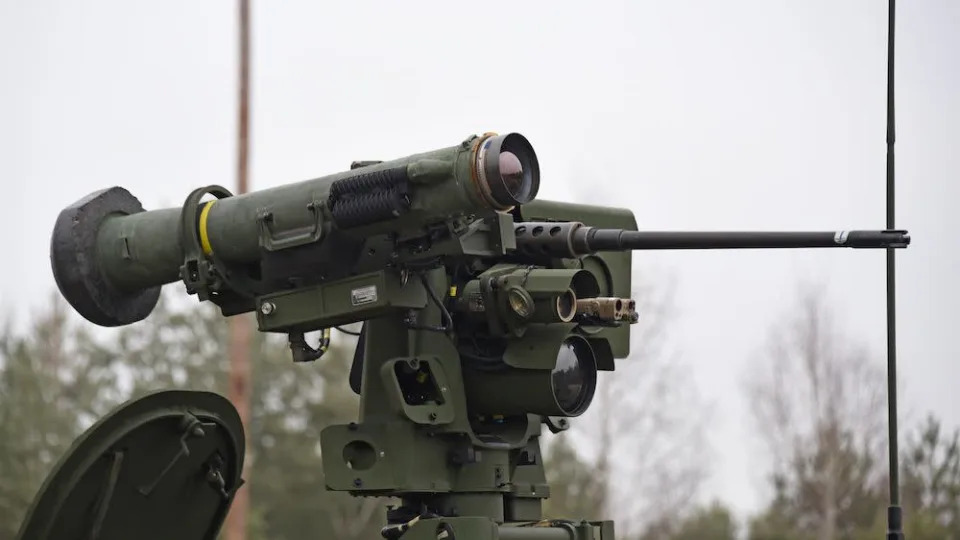Popular Mechanics
These 4 Untested Weapons Could Be Crucial If Russia Pushes Beyond Ukraine
Kyle Mizokami – February 8, 2022

In its attempt to buttress NATO allies and Ukraine in anticipation of a potential Russian invasion, the Biden Administration announced last week the deployment of 1,700 troops of the 82nd Airborne Division from Fort Bragg, North Carolina, to Poland, and the deployment of a squadron of the Germany-based 2nd Cavalry Regiment to Romania. The units, as well as those from the 4th Infantry Division (Mechanized) at Fort Carson, Colorado, still on standby, are full of new weapons and technology.
Here are four untested on the battlefield weapons that could hold the line if Russia pushes beyond Ukraine… or U.S. forces intervene in Kyiv’s behalf.
FGM-148 Javelin Anti-Tank Missile

A lot has been made about the Javelin missile and U.S. shipments of missiles to Ukraine, and for good reason: the 30–year–old medium range anti-tank guided missile was tailor made to confront Soviet, and now Russian, armor formations—exactly the kind massing on Ukraine’s borders.
Here’s a video from the New Zealand Army that breaks down the Javelin missile system and shows an actual launch.https://www.youtube.com/embed/s–9W-4R9aI?v=s–9W-4R9aI&start=0
Javelin was originally deployed in the 1990s, and its 2,187 yard range, infrared targeting, and fire-and-forget launch system were miles ahead of its predecessor, the unfortunate Dragon missile. Javelin was used to destroy bunkers, buildings, and other fortified structures in the post 9/11 era in Afghanistan and Iraq but rarely in the tank-killing role it was originally meant for.
Among troops currently deployed to or deploying to Europe, Javelin will be a key weapon system. Half of the Stryker Infantry Carrier Vehicles used by the 2nd Cavalry are equipped with remote controlled Javelin launchers, and the squadron deployed to Romania might be equipped with as many as 25 Javelins. The unit of the 82nd Airborne Division deploying to reinforce NATO ally Poland is likely a battalion of airborne infantry with attached combat support troops. It would typically be equipped with 18 Javelins missile systems and eight of the heavier, more powerful, longer ranged TOW anti-tank missile systems.
Stryker Infantry Carrier Vehicle – Dragoon (ICV-D)
In the mid-2010s the U.S. Army made the decision to augment the Germany-based 2nd Cavalry Regiment’s firepower. One decision was to upgrade half of the unit’s Stryker vehicles with Javelin missiles, to improve the regiment’s anti-armor capability. The other was the addition of an unmanned turret equipped with a 30-millimeter auto-cannon, creating the Infantry Carrier Vehicle-Dragoon (ICV-D), or Stryker Dragoon. Stryker Dragoons make up the other half of the Stryker vehicles assigned to the 2nd Cavalry.
Stryker Dragoon’s XM-813 30-millimeter cannon is designed to engage enemy light armored vehicles, including Russian BMP-2 and BMP-3 infantry fighting vehicles and BTR-80 wheeled armored vehicles. In combat against a highly mechanized foe, Strykers fitted with Javelins would engage enemy tanks while Stryker Dragoons would engage accompanying scouts and infantry carriers. The XM-813 auto-cannon can fire Mk. 258 Armor Piercing Fin-Stabilized Discarding Sabot-Tracer (APFSDS-T) against armored vehicles and the Mk. 238 High Explosive Incendiary–Tracer (HEI-T) round against trucks, other unarmored targets, and dismounted infantry.
Although the XM-813 arms a diverse variety of weapon systems, including the AC-130W gunship and Zumwalt-class destroyer, Stryker Dragoon has never been in combat.
Infantry Squad Vehicle (ISV)

One of the Army’s fastest new equipment acquisitions in recent years is the Infantry Squad Vehicle (ISV). The ISV is a no-frills vehicle designed to quickly move light infantry troops, particularly airborne infantry, across the battlefield. The ISV is still in testing and is not confirmed to deploy to Eastern Europe, but bringing it along would help the foot-mobile 82nd Airborne quickly deploy across Poland. Poland, a NATO ally that borders Ukraine, is anxious to receive American boots on the ground in case Russian tanks enter its eastern neighbor and just keep going.
The ISV is an unarmored battle truck based on the Chevy Colorado mid–sized truck with the ZR2 off–road package. The ISV is designed to carry nine soldiers, fit inside a CH-47 Chinook helicopter, and be air-droppable along with airborne troops. The vehicle trades armor for light weight and speed, allowing it to get soldiers to their objectives faster. GM Defense could build as many as 2,065 ISVs for the 82nd Airborne and infantry brigade combat teams.
The vehicle is not without controversy. The Pentagon’s Director of Operational Test and Evaluation (DOT&E) recently slammed the ISV in its latest report as “not being operationally effective” in military exercises. The DOT&E complained test vehicles failed to complete reliability testing due to issues such as, “steering capability, cracked and bent seat frames, and engine cracks and overheating.” Still, while the ISV undoubtedly has kinks to work out, there is no real alternative, and the 82nd will have trouble getting around Poland without it.
F-35 Joint Strike Fighter

Last week’s deployment covers ground forces, but any future air power deployment will almost certainly include Air Force F-35A Joint Strike Fighter. The F-35A is a multi-role fighter that can capably handle air-to-air and air-to-ground mission. Unlike its predecessor, the F-16 Fighting Falcon, the F-35 is built from the ground up as a stealthy, low-observable fighter. Most Air Force F-35 units are based in the continental United States with one squadron, the 495th Fighter Squadron (“Valkyries”), based at RAF Lakenheath in the United Kingdom.
The F-35 has already seen combat in Afghanistan and against the Islamic State in Syria and Iraq, but in both cases strikes went unopposed against enemies lacking air defenses. The F-35 has not flown against a peer adversary operating advanced air defense systems and fighter jets like Russia.
Russia’s Tor, Buk, and S-400 surface to air missile systems are some of the most deadly in the world, while Russian Aerospace Forces MiG-29, Su-30, and Su-35 Flanker-E fighters are formidable threats in the air.
